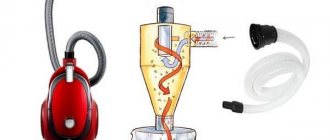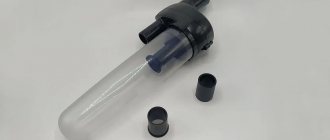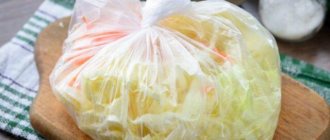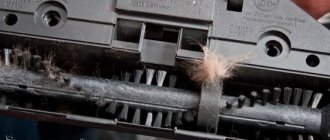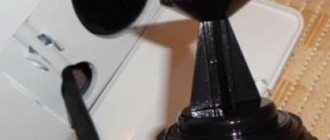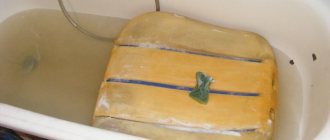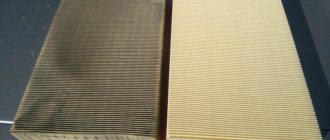Having decided on the type of filter, you should start cleaning it (at least once a month). The paper filter is considered disposable, but you can blow it with cool air and clean it with a stiff brush if it gets a little dirty. Polymer HEPA filters are not afraid of water. Wash in cold liquid, without powders or detergents. If there is a thick layer of dirt, it should be removed with a brush before washing. Wipe the element with a towel. Do not reassemble the unit until the mechanism is completely dry, otherwise moisture will break the motor and the HEPA component will freeze in the ventilated tank.
You will know when the filter element needs cleaning, either by removing dust from the device or by reducing the air flow from the filtration system. Rapid heating of the device is also a sign of blockages. But improper cleaning can lead to problems beyond repair. Before you start, find out if your filter is water compatible.
Description
Hera for a vacuum cleaner
The Hepa filter consists of an accordion-shaped fibrous sheet and a housing that holds it in this state. It is made from fiberglass fiber with a diameter of 0.5-2 microns.
The operation of the unit is determined by the volume of particles released into the environment after the air flow passes through it.
The classification is based on the degree of filtration of small contaminants. It is defined by the standards pr EN 1822/ pr DIN 24183.
It is more correct to divide products into ULPA, HEPA, EPA, but consumers call Hepa filters, because they appeared before the names were divided.
Hera filters for modern vacuum cleaners are divided into classes.
| Hera filter class | Dust retention percentage |
| 17 | 99,999995 % |
| 16 | 99.9999 5% |
| 15 | 99.9995 % |
| 14 | 99.995 % |
| 13 | 99.95 % |
| 12 | 99,5 % |
| 11 | 95 % |
| 10 | 85 % |
It is necessary to pay attention to the class when purchasing an additional filter for a vacuum cleaner. The higher it is, the better and more reliable the product.
Cleaning methods
The reusable filter unit, made of fluoroplastic fibers, can be cleaned. Washing is carried out with strong water pressure without brushes or detergents, so as not to damage the mechanism. Then you need to dry it at room temperature. Users wonder if the hepa filter can be washed frequently. Washing is carried out at least 4 times a year. But even washable products are not recommended to be used for more than two years, because water causes them to lose their properties and become deformed.
Another question arises, is it possible to wash HEPA with a cellulose filter. Disposable paper products should not be attempted to be cleaned because... this will lead to a decrease in the efficiency of their work and the appearance of mold fungi. You can try to clean a filter that is unwashable by blowing air, but this is ineffective. Many dust microparticles are retained between the fibers, cling to them and penetrate inside.
Popular types and models
Bosh Nera filter
Kinds:
- Disposable ones are made from fiberglass or paper. They have a particle throughput of up to 0.3 microns and a service life of up to 6 months.
- Reusable ones are made of fluoroplastic, they can be washed and used for 2 years. They prevent the passage of contaminants up to 0.06 microns in size. They cost more than disposable ones. The names are marked with a W. They are also called Eptfe.
Thus, to decide whether the hepa filter can be washed, you need to consider whether it is disposable or reusable. The price of the device is determined depending on the type, class and brand of the manufacturer. For example, disposable paper filters according to the standard belong to a lower class, unlike fluoroplastic filters, and they will cost less. Let's consider the cost of several devices from the most popular companies.
- Washable Hepa from Bosh H14. Complies with filtration class H14 of the European air hygiene standard. Suitable for vacuum cleaners of the BGS 4 series: BG 42230, BGS 42234, BGS 42242, BGS 4GOLD. Cost - 1400 rubles*.
- Hepa filter H12 for Zelmer vacuum cleaners. Made in Poland. Consists of a special multilayer material. Suitable for models: Galaxy Solaris Twix 5500, Clarris Twix 2750. Cost - 1100 rubles.
- Hepa 13 for DS5500/5600/6000 Mediclean vacuum cleaners. Made in Germany. Cost - 1421 rubles.
- Nera Miele SF-HA30. The device has an integrated replacement indicator, which is activated after installation. A special arrow that lights up in red indicates that it is full. Using an additional function, you can monitor the efficiency of the unit. The plastic case is characterized by strength and resistance to mechanical damage. Cost - 2199 rubles.
- Hepa filter TEFAL ZR005701 belongs to class 10, designed for use in bagless vacuum cleaners of the TW25 series of the Tefal brand. The model consists of a plastic body, a thin layer and deep fibrous material. Its cost is 1099 rubles.
The air passes through the fine cleaning device last, the dust is crushed into even smaller ones, which cannot be seen. The better the model, the more it crushes the dirt.
These products are produced not only by such well-known brands as Philips, Electrolux, Thomson, but also by lesser-known manufacturers. Famous brands often produce filters for their products, and they may not fit the equipment of other companies. This increases the company’s income, since the user in such cases turns to the “native” supplier.
Stages of filtration in vacuum cleaners
The vacuum cleaner sucks in air and debris due to the operation of a turbine mounted on an electric motor. To prevent all particles from passing through it, like through a pipe, and also to avoid clogging the turbine and electric motor, it implements several filtration stages:
- Rough cleaning.
- Engine filter.
- Exhaust air filter.
Rough cleaning or where garbage is stored
Typically, the function of the first filter and garbage collector is performed by either a plastic container (in more expensive models) or a garbage bag (more common in cheap models).
The bag can be made either of thick fabric, in which case it is reusable, or of filter paper - it is disposable. The bag is installed between the inlet hose and the engine filter. Paper bags are convenient because you don’t need to empty them - you clean your apartment and throw them in the trash, but you need to constantly replenish their supplies. Fabric bags are reusable, but they need to be shaken out each time and sometimes cleaned with a hard-bristled brush to remove accumulated dust deposits.
There may also be a water tank created for the same purposes as described above.
Fine cleaning
A filter is installed between the debris tank and the engine with the turbine to retain small dust particles. It is often made of fiber pressed into a thin sponge or a material like a foam sponge. Its task is to prevent large particles from entering the engine compartment.
A third filter for microscopic particles is installed at the outlet of the vacuum cleaner. It is necessary in order not to blow dust out of the vacuum cleaner that was not retained by the bag and the motor filter. In this case, sponges made of pressed fibers are used in the cheapest models, or HEPA filters (High Efficiency Particulate Air) in mid- and high-segment models. Carbon filters can also be used - they purify not only the air from dust particles, pollen and dust mites, but also from unpleasant odors, which is especially important in the apartments of smokers.
Vacuum cleaner fine filter
Criterias of choice
Hepa filter for Miele vacuum cleaner
The efficiency of a unit with a Hepa filter depends on the following parameters:
- material of manufacture;
- fiber diameter;
- packing density.
The suction power is directly proportional to the size - the larger the size, the better the suction. The folds in the unit should not be located often and not very tightly, evenly over the entire surface. The higher the cleaning class of the Nera filter for a vacuum cleaner, the more fragile and delicate components are used in it. Well-known manufacturers make a plastic frame for protection. It is better that it is located over the entire area, and not just a frame around the edge.
Many units are treated with an antimicrobial solution, which prevents the proliferation of microbes.
Note! On the casing material. The filter and the block must be adjacent to each other. If there is no airtight seal between the two mechanisms, operation will become ineffective.
How to clean a cyclone filter
The filter container is cleaned of compressed dust after each cleaning of the apartment with a vacuum cleaner.
- We open the compartment with dirt above the garbage bag and dump out the dusty compact.
- Next, check if there are any additional lids in the container; often in the center there is a compartment that creates an air funnel in which hair and pet hair can get wrapped up.
After removing the main dust from the cyclone filter storage container, wipe it with a slightly damp cloth to remove the layer of dust settled on the walls.
Cleaning the aqua filter
The water filter in a vacuum cleaner is a bucket filled with water and detergent.
After cleaning the apartment, the liquid must be drained into the toilet, otherwise the equipment will deteriorate and fungus will appear in the compartment.
Cleaning this filter involves cleaning the walls of the container from dirt residues that remain in abundance after draining the liquid. After rinsing the bucket, it is advisable to dry it and only then insert it into the vacuum cleaner connector.
Filter types
In a nutshell, the principle of operation of a vacuum cleaner can be described as follows: by the thrust created by the motor turbine, it draws in air, and with it dirt. All this passes through a filter system, the dust remains inside the device body, and the clean air goes outside. Typically, vacuum cleaners implement the following cleaning steps:
- preliminary:
- main filtration system;
- fine cleaning at the outlet.
Dust collectors (first stage of cleaning)
The biggest obstacle to dirt is the dust collector. In different models of vacuum cleaners it can be implemented as follows.
- Dust bag. Typically, this option is available on inexpensive, not the most powerful devices. It can be woven, which must be cleaned after cleaning, or disposable paper. Structurally, the dust collector is located between the inlet tube and the motor prefilter.
Vacuum cleaner with dust bag
Vacuum cleaner with dust container
Vacuum cleaner with aqua filter
Fine filters
This cleaning step is two-stage. The first filter is located between the dust collector and the motor, and is designed to protect the engine itself. It is usually made of a dense but porous material (similar to foam rubber) and holds fairly large dust particles.
To ensure that only clean air leaves the vacuum cleaner, there is a fine filter at the outlet that can trap microparticles of dirt and dust. In inexpensive models, fine cleaning is carried out with pressed fibrous material. In more expensive ones - HEPA filters. Some vacuum cleaners have carbon filters that cut off not only dust microparticles, but also unpleasant odors.
How to clean the filter element in a Samsung device?
To ensure the highest quality cleaning, modern Samsung vacuum cleaners are equipped with a multi-stage filter system consisting of:
- bag (container) for collecting garbage,
- coarse and fine filters.
In order for a household appliance to operate without interruption, each filter must be cleaned promptly and correctly.
Cyclone (with dust container)
A cylindrical plastic container with a lid and handle, into which dust and debris from the air settles under the influence of centrifugal force, is called a cyclone filter (in Samsung vacuum cleaners, it is fixed on the side of the body).
Cleaning the flask is very simple:
- Disconnect the device from the electrical network.
- Pull the container out of the vacuum cleaner body by the handle.
- Open the container, shake out the debris and dust.
- Using a soft sponge and soap solution, clean the walls of the container from dirt and rinse it under running water.
- After waiting for the container to dry completely, cover it with a lid and place it in its original place.
If water gets into the cyclone filter during cleaning, the household appliance must be turned off immediately, the container removed and cleaned. Otherwise, dust and debris, mixed with water, will be compressed and clog the filter element, which significantly reduces the suction power of the vacuum cleaner.
The process of cleaning the filter is in the video:
Aquafilter
The air filtration system using water (aquafilter) is a container partially (1/3) filled with water inserted into the body of the vacuum cleaner. Passing through the aquafilter, dust from the air is moistened and settles at the bottom of the container.
To clean the aqua filter, you need to:
- remove the container from the body of the household appliance;
- open the container;
- pour out dirty water;
- Rinse the container under running water.
The water filter is cleaned after each cleaning. Otherwise, you will have to make a lot of effort to get rid of the musty smell of stagnant dirty water.
NERA
The HEPA fine air filter traps the smallest (up to 0.6 microns) dust particles. You can find the HEPA filter on the back panel of the vacuum cleaner behind a special grille (it looks like a dense accordion made of fibrous or polymer materials, placed in a plastic frame).
To clean the HEPA filter, you need to carry out a series of sequential steps:
- disconnect the vacuum cleaner from the electrical network;
- open the grille hiding the filter element;
- remove the filter accordion from the plastic housing;
- Gently clean the filter with a soft brush, then rinse under running water.
After cleaning, the filter accordion must be thoroughly dried. Only after drying is it placed back into the plastic case and then into the vacuum cleaner.
Foam rubber
A fine filter made of foam rubber is installed in front of the motor of a Samsung vacuum cleaner. Caring for the foam filter element is very simple:
- Disconnect the household appliance from the electrical network.
- Open the lid of the vacuum cleaner, take out the garbage collection bag (in some models, a plastic container is installed instead of a bag).
- Under the dust collector there is a plastic frame with a handle, into which a foam filter element is inserted.
- Remove the filter, moisten it with water, soap it with laundry soap, and rinse under running water.
- The well-dried part is returned to its original place.
To prevent the foam from tearing and retain its shape, it should not be squeezed, stretched or twisted after washing. The foam must be carefully laid out on a flat surface and allowed to dry naturally.
Carbonic
Samsung premium vacuum cleaners are equipped with a special carbon filter. This plastic form, filled with pressed carbon granules, traps not only dust particles, but also unpleasant odors (interestingly, the filter continues to work even when the vacuum cleaner is turned off).
Even though the carbon filter is quite expensive, it can only be used once. The maximum that can slightly extend its service life is cleaning small dust particles from the outside of the case with a soft brush.
How to clean a Samsung vacuum cleaner
If you want your vacuum cleaner to serve you for a long time, take the time to pay more attention to your electrical appliance. It is worth cleaning your vacuum cleaner after each cleaning, but each model needs to be cleaned differently. Is it so difficult to clean vacuum cleaner filters and other components? Nothing special. This article can clearly demonstrate this to you, which will describe ways to clean a Samsung, LGI, and any other brand vacuum cleaner.
Cleaning the vacuum cleaner
Cleaning a vacuum cleaner is not as difficult as it might seem, but there are some nuances here too.
To consider them, it is worth paying attention to the operation of filters:
- Dust collected by a vacuum cleaner is accumulated in a special dust bag or in an aquafilter.
- The device is being cleaned from clogging.
- Then fine cleaning occurs. Sometimes HEPA filters are used for this step.
There are several types of filters, which will somewhat influence how to clean a Samsung vacuum cleaner:
- Bag. The material used is synthetic fiber or paper. There are both reusable and disposable bags.
- Aquafilter. The point is that it is located above the water, and dust, penetrating into the cylinder, becomes wet and settles at the bottom.
- Coarse filters. This is where large debris accumulates, which leads to an early filter replacement.
- Fine cleaning. This is where things get a little more complicated. There are electrostatic and HEPA filters. They effectively deal with small particles, and better filters can destroy both plant spores and a variety of allergens.
- Cyclonic. Such filters must be cleaned of dust and dirt after each use.
Important! Sometimes situations occur when it is impossible to clean or repair a vacuum cleaner without first disassembling it. We will tell you how to do this correctly in another of our articles, “How to disassemble a Samsung vacuum cleaner?”
Cleaning process
To get rid of dirt inside the vacuum cleaner, you need to follow these instructions:
- Turn off the power to the device.
- Remove the hose and remove all filters: dust bag, filter, motor and final filter.
Important! The vacuum cleaner model may have additional filters that also need to be removed
- Clean the dust collector chamber from dirt using a damp cloth. Carefully wipe all parts, cracks and gaps where dust may accumulate.
- Clean the engine compartment by plugging in the vacuum cleaner and blowing air through it.
Important! The dust cleaning process will go faster if you tilt the device slightly when blowing and slightly open and cover the hole with your hand, which is designed to connect to the hose.
- Replace old filters and bags with new ones if for some reason they become unusable. Reinstall all components.
- Clean the turbo brush, nozzles, and other components used for cleaning. All foreign objects and particles must be removed. To remove, you can use thin sharp objects or tweezers.
Important! Be careful when using sharp objects. Try not to damage the household appliance
How to wash a vacuum cleaner?
Cleaning a vacuum cleaner may also include elements of wet cleaning. The following instructions demonstrate this:
- Wear light, loose clothing that you are not afraid to get dirty.
- Unplug the device and wipe its body with a slightly damp cloth.
- Remove the dust container, empty the contents, and wash it.
- Some models do not have a dust collector, but are equipped with a special container, which also needs to be emptied, washed, and dried.
- If your vacuum cleaner has an aqua filter, do not neglect cleaning after each use. Such filters require a lot of attention to care.
- Washing vacuum cleaners can be cleaned by lowering the hose with the nozzle, plugging the device into the mains for 7-10 minutes, after which the device must be dried.
- At the last stage, the brush and other external parts of the device are cleaned.
Adviсe
If necessary, it is very easy to replace the foam filter with a new element, cut according to a pattern from dense foam rubber (a dishwashing sponge is excellent).
If you rinse the foam filter in water with the addition of fabric softener, the vacuum cleaner will not only collect dust during the cleaning process, but will also additionally freshen the air.
In order not to make a mistake in choosing a new filter, before purchasing you need to clarify which model of Samsung vacuum cleaner it is intended for (information is indicated on the packaging of the filter element).
Particularly dirty fabric dust collectors can be cleaned by washing them in an automatic machine. To do this, place the bag, previously cleared of debris and dust, into the washing machine, set the quick wash mode, and add washing powder. After the dust collector has been thoroughly dried, it can be used again for its intended purpose.
Recommendations for cleaning different types of filters
Some housewives try to clean and reuse disposable filters. This is mistake. After washing, such a filter may look clean, but it loses its working qualities.
Attention! A decrease in suction power, as well as a “straining” sound during operation, may indicate a clogged hose or dirty filters.
Dust bag
Paper or thin non-fabric dust collectors are disposable. To clean a large house, such a bag is enough for 2-3 times. If the apartment is small and there is not much dust, then you can change such a dust collector once every few weeks.
Disposable nonwoven bag
Woven bags are dense with a plastic adapter and a rubber seal, they can be cleaned and even washed carefully.
The dust bag is located either behind the front panel of the device or behind a special hatch, usually there is a designation on it. In any case, the cover must be removed. Next, you need to disconnect the bag. It can simply be inserted into the holder and snapped into place; in this case, it is enough to simply push it carefully in the desired direction and remove it. It happens that the dust collector is additionally secured with a clothespin. You need to unfasten it using the lever, and then take out the container with garbage.
Vacuum cleaner with fabric bag
Cyclone filter container
A cyclone filter works like this: it spins the flow of dirty air in a spiral, and all large particles are “nailed” to the walls of the container. More often it is a flask on the handle, sometimes a container in the body itself. Before removing the dust collector, you must disconnect the device from the power supply. Next, you need to throw out the garbage from the container; usually it produces almost no dust and is collected in clumps. Then rinse the plastic container and dry it.
Dyson vacuum cleaner with cyclone filter
There are no parts in such a container that require any complex care. This is a separate plastic element with simple geometry, so maintaining such a filter is not difficult.
Aquafilter
This filter has maximum efficiency. It is a container inserted into the body of the device hermetically, without communication with other parts and partially filled with water. Air with dust gets inside, the particles settle in the water. And clean air comes in from above. Caring for this type of container is simple: pour dirty water into the toilet and rinse the container if necessary. Afterwards, you can install the filter back and the vacuum cleaner is ready for use again.
Thin foam filter
Foam filters are used for fine air purification in front of the engine and at the outlet of the entire system. Cleaning them is simple: you can “knock out” a little dust, clean them with a soft brush (like a toothbrush), or better yet, wash them. They wash well, and the detergent also disinfects and deodorizes the filter.
Foam filter in a vacuum cleaner
Important! To ensure that the filter does not tear and retains its geometry after washing, it is not wrung out. It should dry on its own when laid out on a flat surface. You must also use the brush carefully so as not to tear the filter or damage its structure.
You can make the filter yourself: cut a part according to a sample from dense foam rubber of suitable thickness.
HEPA filters
HEPA filters are effective and technologically advanced. They come in disposable paper and polymer. The latter can and should be cleaned periodically. They are a dense accordion made of base material, enclosed in a plastic frame. It is convenient to clean them with a long-bristle brush of medium hardness. The filter can also be washed and dried.
How to get the filter:
- disconnect the vacuum cleaner from electricity;
- open the access hatch to the dust collector;
- first take out the container, then access to the filter will open, take it out.
Often the second filter is located at the back, behind a special grille. It comes out in one motion.
Attention! Before removing any element, you must make sure that it is not closed with locks, latches, etc. If the filter is fixed, you first need to unlock it by pressing a button or latch lever and only then take it out.
Carbon filter
This filter is installed in expensive models of vacuum cleaners; it itself is also expensive, so it is rare. Its specificity is that it retains not only dust particles, but also odors, deodorizing the room (and it does the latter even in an inactive state).
Carbon filter for Miele vacuum cleaner
The filter is a plastic housing filled with carbon sorbent. Such filters are not suitable for reuse. You can extend its life by brushing off external dust with a brush.

